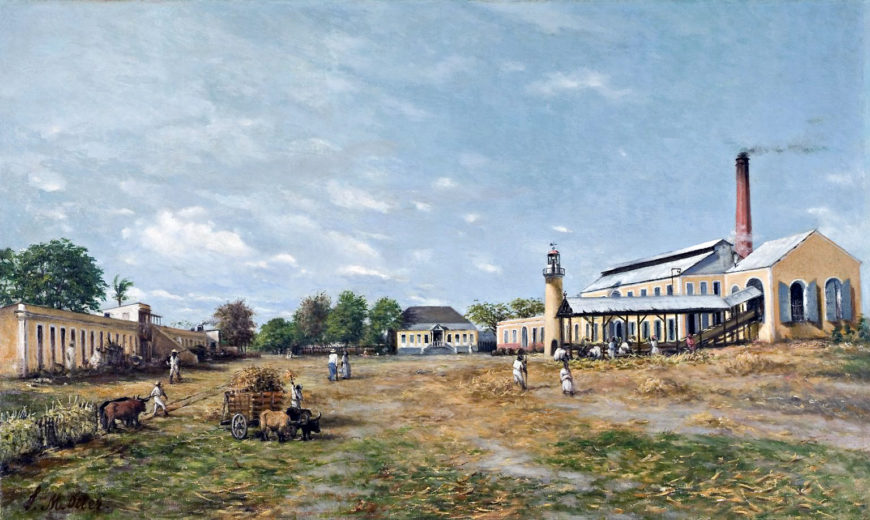
Francisco Oller, Hacienda La Fortuna, 1885, oil on canvas, 66 x 101.6 cm (Brooklyn Museum)
A sugar plantation dominates and frames the Puerto Rican landscape in Francisco Oller’s Hacienda La Fortuna. Hacienda workers labor, surrounded by the factory buildings and the owner’s residence behind them. A field dominates the foreground, with workers transporting and gathering cane from the previously harvested portions of the field to be taken to the mill. The remnants of the morning fog are still present. It’s a busy plantation—the crop is bountiful and the chimneys are smoking. When Oller painted this in 1885, the sugar economy in Puerto Rico had been in steady decline for decades. Why did he paint Hacienda La Fortuna as a bustling enterprise? And how does it compare to his Hacienda Aurora painted 13 years later?
The commission
The combination of a drought in the 1840s and the 1855–56 cholera outbreak, which considerably impacted the enslaved population that worked on plantation sugar fields, marked the start of the sugar industry’s decline in Puerto Rico. Further decline occurred because of the abolition of slavery in 1873 and the lack of funds to invest in technological updates like steam-driven mills. The result was that sugar exports from Puerto Rico started crashing in 1873. After a period of depression in the international sugar market in the first half of the 1880s caused the closing of many ingenios (sugar plantations), the local industry saw some stability return after 1885. While the remaining plantations saw some economic growth in the following years, the sugar industry would not recover its former standing during the remaining 13 years of the Spanish administration in Puerto Rico.
Despite this recent economic history, the Spanish businessman José Gallart Forgas bought and invested in five ingenios in the south of Puerto Rico. [1] Among these was Hacienda La Fortuna in the southern town of Ponce, portrayed in the painting as a place of orderly and serene productivity. Gallart Forgas commissioned Oller to paint all five of his plantations. La Fortuna, however, would be the only one painted by the artist, as he later abandoned the commission after finishing this first canvas. [2]
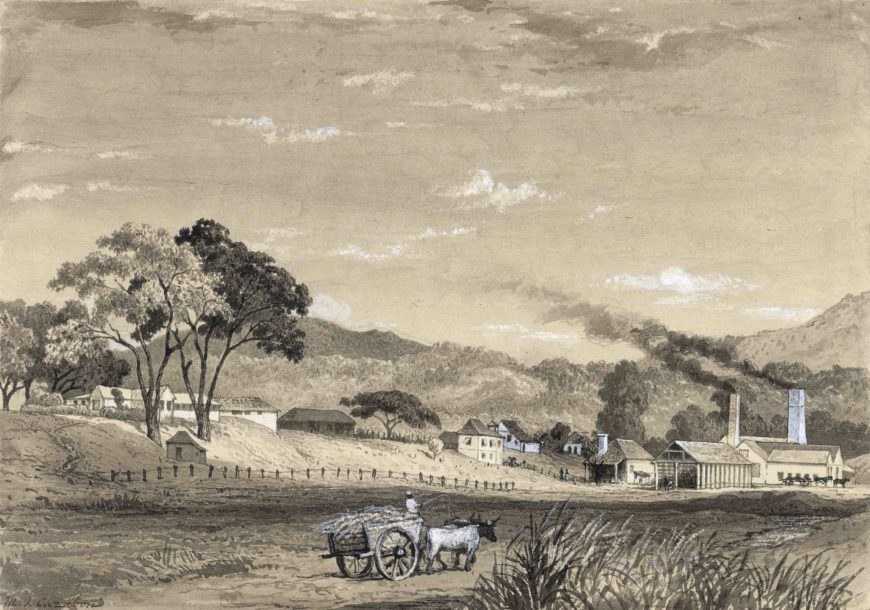
Michel-Jean Cazabon, Garden Estate, Arouca, 1857, pen and black ink, gray ink, gray wash, black wash, graphite, gouache, and scratching out on medium, slightly textured, beige, wove paper, 18.1 × 25.4 cm (Yale Center for British Art, Paul Mellon Collection)
Oller’s painting is a portrait of property—an image meant to capture the scale and wealth of the property for the enjoyment of its owner. Similar representations of sugar plantations were popular in the British Caribbean, such as Garden Estate, Arouca by Trinidadian painter Michel-Jean Cazabon who was commissioned by William Hardin Burnley in the late 1840s to paint twelve of his properties and plantations in Trinidad. These paintings often responded to the English taste in the picturesque that included compositional formulas such as meandering paths to guide the eye, anonymous peasants or workers, and stylized natural features. These conventions were used to create idyllic landscapes, and the backbreaking work carried out in these plantations is rarely portrayed; when it is, it’s done in an orderly and idealized manner. We can see this in Garden Estate, Arouca, with a lone worker transporting cane in the foreground. The path he is on guides the viewer to the plantation in the middle ground. Lit chimneys indicate the planation is busy, even though only four figures can be identified around the buildings. The quiet scene contrasts with the reality of the labor needed to manage a plantation. In Cazabon’s composition, the plantation seems to be a natural part of the landscape with little reference to the considerable effect cane fields and plantations have on the land. Cazabon’s image was one of many romanticized representations of a plantation, which were popular among absentee owners, such as Gallart Forgas, who returned to Spain with Oller’s painting shortly after he commissioned the series. [3]
In Hacienda La Fortuna, Oller doesn’t rely on picturesque conventions such as we see in Cazabon’s Garden Estate, Arouca. Oller painted the sugar plantation from the working fields, with its buildings dominating the landscape. The foreground depicts a portion of the harvested field with three figures, one of them filling an ox-pulled cart. Other figures are around the property. In the lower left-corner of the painting, another pair of oxen pull carts loaded with sugar cane. This detail hints at the vastness of the property and the fields beyond the painting’s borders.
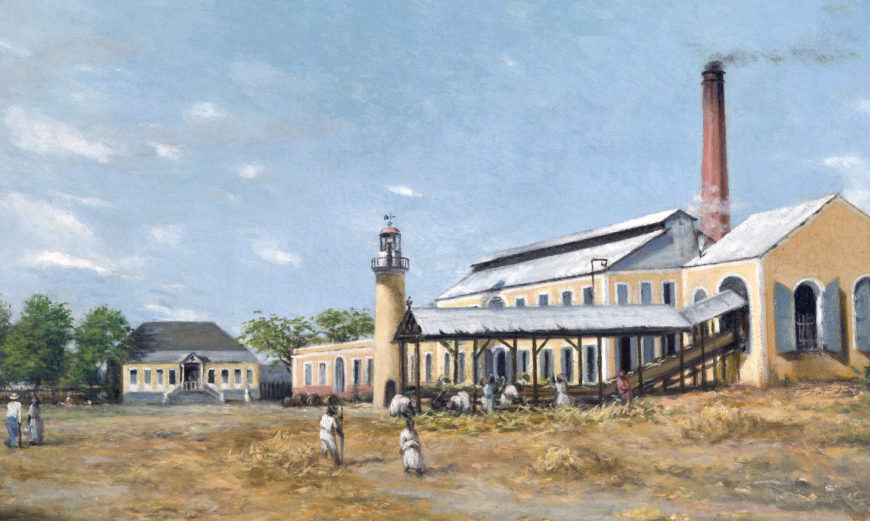
Detail of the sugar mill with people working. Francisco Oller, Hacienda La Fortuna, 1885, oil on canvas, 66 x 101.6 cm (Brooklyn Museum)
Oller provides no clear path to guide the viewer’s eyes through the painting. The big sugar mill in the middle ground dominates the composition with a line of workers outside loading and cutting the cane brought to be processed in the mill. Two smoking chimneys point to the production inside. The white smoke of the smaller chimney may hint at the use of a steam-powered mill, which was a sought-after technological advancement to accelerate the process of crushing the cane and extracting its juice. The brick chimney releases the smoke of the fires used for the boilers to heat the cane juice to make molasses and raw sugar.
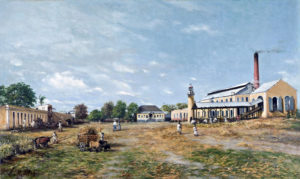
Francisco Oller, Hacienda La Fortuna, 1885, oil on canvas, 66 x 101.6 cm (Brooklyn Museum)
A one-story building, likely storage or workers’ lodgings, is placed across from the mill (on the far left side of the painting) and Oller has placed the owner’s residence at the center of the composition. All three buildings share the same shade of yellow, visually connecting them as part of the plantation.
Oller seems to have tweaked the perspective to bring both the house and the cane fields closer to the working buildings. Typically, the owner’s mansion was removed from the fields and work buildings on the plantation. With a low horizon line and the owner’s residence close to the field, the three buildings frame the central field and the workers. While not literally portrayed, Gallart Forgas is ever present, supervising his land through the representation of his residence.
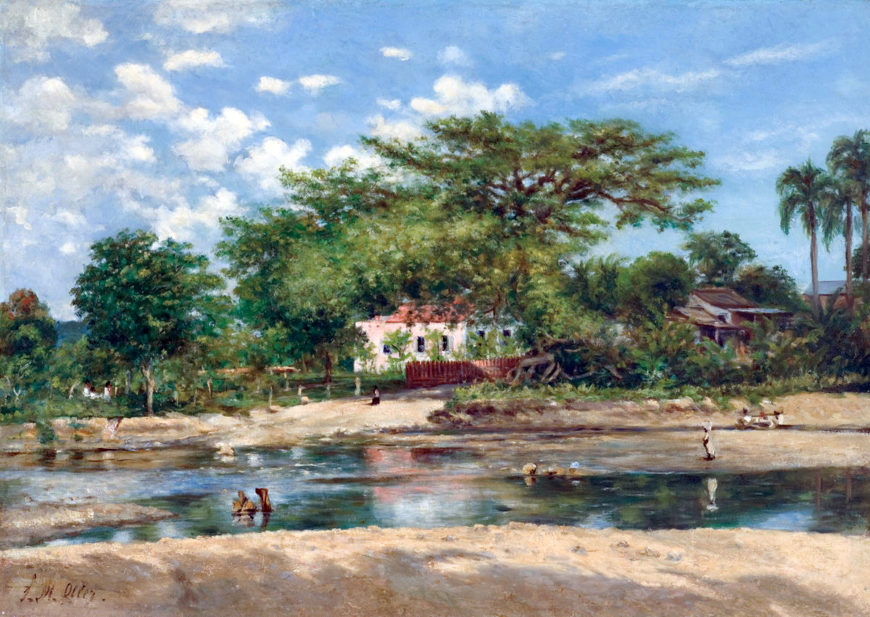
Francisco Oller y Cestero, The Old Ceiba Tree at Ponce, 1887–88, oil on canvas, 18 1/2″ x 27″ inches (Museo de Arte de Ponce)
The artist’s return to Puerto Rico
Hacienda La Fortuna is Oller’s first known ingenio landscape. This painting was produced in a moment when Oller was revisiting the landscape of his native Puerto Rico after spending a decade in France and Spain. During those years he became reacquainted with some of his impressionist friends, adopting this style for his landscapes. After returning to Puerto Rico in 1883, he traveled around the island, staying with friends in the countryside and practicing plein-air painting (painting out-of-doors), a strategy employed by many Impressionist painters.
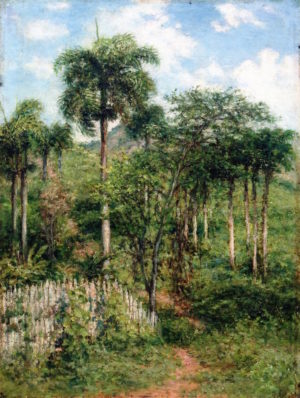
Francisco Oller, Landscape with Royal Palms, c. 1897, oil on canvas, 46.9 x 34.9 cm (Ateneo Puertorriqueño)
He developed a fascination with elements of the Puerto Rican landscape, including palm trees and the ceiba (silk-cotton tree). This mirrors what was happening in local literature since the mid-19th century, where these distinctive features of the landscape were becoming symbols of Puerto Rico. Oller’s attention to them speaks of his own interest in representing what defines his local landscape. In paintings like The Old Ceiba Tree at Ponce, a giant ceiba dominates the middle ground with its abundant foliage hiding most of its trunk and shrouding the pink house at the center of the composition. It is no surprise that sugar plantations and farms also became one of these distinctive elements in Oller’s work. While they were private enterprises, they modified the landscape and were important to the local economy.
Sugar plantations are a phenomenon tied to European colonization of the Americas. Sugar production defined the economy and landscape of many Caribbean islands, particularly from the second half of the 18th century onward, as French, English, and Spanish colonial administrations invested in sugar production in this region. The cane fields, the imposing brick chimneys of the plantation boilers, the international exportation of the finished product, the harsh labor and exploitation of enslaved people and workers—all of these defined the landscape, economy, and lives of many throughout the 1700s and 1800s. Sugar plantations became as representative of the region as its nature.
The reasons Oller stepped away from finishing Gallart Forgas’s commission are unknown. He may have initially taken the commission due to economic reasons, though it is possible that the strong association of plantations with slavery soured this project for him. He had abolitionist ideals and had painted portraits of Puerto Rican abolitionists, including Román Baldorioty de Castro. In a now-lost work titled Un boca abajo (Face Down) painted around 1868, he denounced a brutal punishment carried out on sugar plantations, showing an enslaved person on their stomach tied to the ground about to be whipped. The backdrop of the scene was an ingenio.
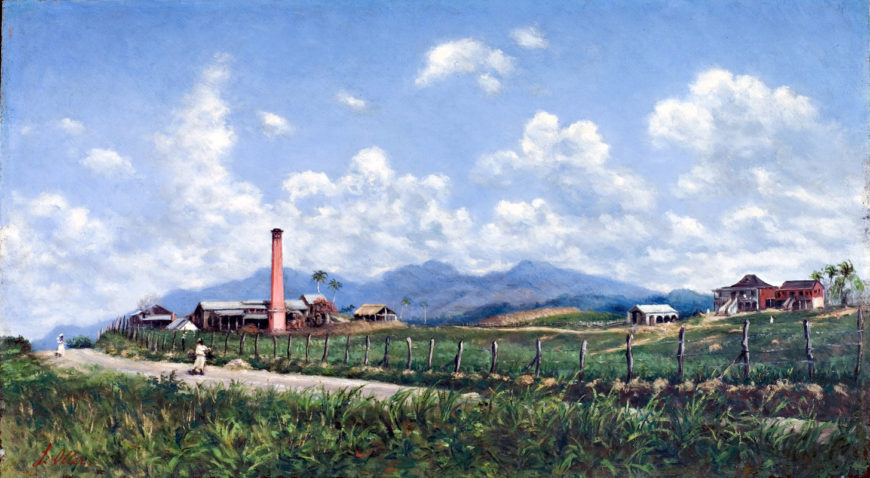
Francisco Oller y Cestero, Hacienda Aurora, 1898, Oil on panel, 12 5/8 x 21 7/8 inches (32 x 55.6 cm) (Museo de Arte de Ponce)
A changing view of the sugar plantation
Other sugar plantations found in Oller’s work tend to be smaller operations that still employed traditional methods, like animal powered mills, and depict fewer workers and less activity. By the mid 1880s and the early 1890s, the sugar industry was seeing some changes with more money poured into bigger, steam-powered mills known in the region as centrales.
Painted 13 years later, Oller’s Hacienda Aurora offers a compelling contrast to Hacienda La Fortuna. This other ingenio was located in the northern town of Carolina and owned by Manuel Saldaña, a friend of the artist. Oller and his family stayed there during the Spanish-American war in 1898, and it is likely the painting was a gift to his host. The four months long conflict saw the bombardment of San Juan by the U.S. Navy, as well as food scarcity and inflation in imported goods that affected most of the population.
By then, the old mill in Hacienda Aurora had been virtually abandoned. Saldaña had already inaugurated a new and bigger operation in 1887, Central Progreso. In the painting, Oller offers a panoramic view of the property, using a dirt road and fence to indicate its limits. Beyond the simple fence are the plantation buildings. Cane fields in the middle are sandwiched between a rustic mill on the left and the Saldaña residence on the right. The background is defined by an expansive sky and the hazy Sierra de Luquillo. Only a couple of figures meander around the house and two women dressed in white walk through the road in the foreground. They are part of the landscape but not necessarily tied to the plantation as workers because they stand outside the property. The smoke of the mill’s small chimney suggests activity, but the tall brick chimney is unlit. The old plantation is not in operation.
While the busy plantation in Hacienda La Fortuna seems to predict the coming market stability of its time, or at least its hope, Hacienda Aurora, painted some 13 years later, is a shadow of what it once was—a near empty plantation in the wake of great change. Oller created an almost nostalgic composition, a complicated vestige of another time as the country itself experienced an intense transition at the end of the Spanish-American war.
Notes:
[1] Aste, Richard. “Art of the Spanish American Home at the Brooklyn Museum”, Behind Closed Doors: Art in the Spanish American Home, 1492-1898 (New York: Brooklyn Museum, 2013): p. 44.
[2] It seems Oller was that one to step away from the commission, but we don’t know the reasons. It is likely that he took the commission due to monetary reasons; while he came from a socially respected and well-connected family in San Juan, they did not have a lot of money and economic woes followed Oller all his life. The commission was continued by a former student of his, Pio Casimiro Bacerne, so it seems Forgas continued to be interested in the series.
[3] Sullivan, Edward J. From San Juan to Paris and Back (New Haven: Yale University Press, 2014), pp. 70–71.
Additional resources
Richard Aste, “Art of the Spanish American Home at the Brooklyn Museum,” Behind Closed Doors: Art in the Spanish American Home, 1492-1898 (New York: Brooklyn Museum, 2013), pp. 17-47
Osiris Delgado Mercado, Francisco Oller y Cestero: Pintor de Puerto Rico (San Juan: Centro de Estudios Superiores de Puerto Rico y el Caribe, 1983).
Tamara Díaz Calcaño, “Michel-Jean Cazabon y Francisco Oller: pintura y sociedad en el Caribe decimonónico,” PhD. diss., (Complutense University of Madrid, 2019).
Edward J. Sullivan, From San Juan to Paris and Back (New Haven: Yale University Press, 2014).

